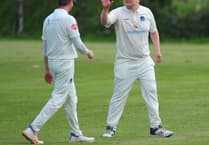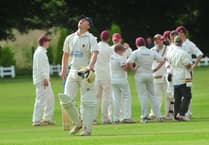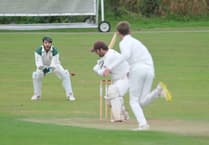With the club commemorating its 125th year since it was formed Norma Thewlis looks back at a slice of its golfing history.
the year 2015 is one of famous anniversaries – 800 years since the signing of the Magna Carta, 600 years since the Battle of Agincourt, 200 years since the Battle of Waterloo and 70 years ago we celebrated the end of the Second World War – all events that had a significant impact on the history of this country.
Another commemoration to celebrate this year is the 125th anniversary of Tavistock Golf Club – not as earth shattering as the events above but the start of a golf club that, over the decades, has become one of Devon's most prestigious.
Tavistock is the oldest of all the county's moorland courses and its existence is due to a Mr J R Divett who, together with a small group of other enthusiasts, conceived the idea of carving a course out of the heather and gorse on Whitchurch Down. This was a bold idea for in 1890 golf courses were either sea side links or on the smooth fairways of Wentworth. Permission had to be obtained from the Duke of Bedford and, in a letter dated November 28, 1890, this was granted with a rent of 1/- per annum. The Commoners shortly afterwards also agreed at a payment of £5.2s 0d per year. By February the course, thought to be set out where the Pimple is now, was ready for play. It was not until later in the year a clubhouse, called the Iron House, was built at a cost, with lawn mower, of £52, and opened in woods on the Whitchurch side of the Pimple.
The construction of the course did, obviously, have an impact on a small area of Whitchurch Down but, we assume, very little on the town of Tavistock. The mining boom was over, during which time the population peaked at 9,000, but by 1891 the census showed the population had declined to 6,252. Nevertheless, great changes had occurred – the sweeping away of the slum area of narrow streets and mean houses to be replaced by the Town Hall, Pannier Market and Duke Street — all due to the power and patronage of the Duke of Bedford. A new road, westward from Bedford Square, had been built providing speedier access for travellers from Plymouth and for residents a pleasant aspect. The Bedford was the home of the Duke of Bedford's estate manager and one of the most prestigious houses in the town. It was the estate office, next to the Bedford Hotel and now occupied by a firm of accountants, that responded to the requests, petitions, pleas and begging letters sent by local people.
The town had the advantage of a long history as a market town and, at the end of the 19th century, dozens of tradespeople, business men, agents and artisans occupied premises in the town centre serving a large outlying population as well as the townsfolk. In Brook Street there were 38 businesses — five grocers, three confectioners, drapers and inn keepers, an ironmonger, a watch maker, stone mason, cabinet maker, coach builder, gas fitter, saddlers, coal merchant, tailor, builder, decorator, glass dealer and an insurance agent, as well as a coffee house and brewery.
In the late eighties a middle aged miner founded a grocery store. His daughter Winifred carried on the business with her husband Henry Creber — a shop that still retains the name.
It was with these two great assets —the Duke of Bedford and as a historic market town — that Tavistock gradually overcame the loss of the mining industry. However, it must be remembered that, despite the Duke's epic slum clearance, new buildings and roads, poverty and disease was still rife with a soup kitchen a regular feature during the winter. Death rate figures were very high particularly for children. It was only towards the end of the 19th century that they began to fall and in 1903 only 11 children below the age of one died in Tavistock.
The Duke of Bedford also played a major part in establishing the golf club. After granting permission for the building of the course he also agreed to become patron of the club. According to the battered membership book in November 1890 it is recorded that 'Twenty three gentlemen formed the club, the original rules were drawn up at a meeting held on December 5, 1890. Play commenced on February 11, 1891'.
Though this seems a very short time for a course to be constructed it was only nine holes laid out between gorse and heather and, one imagines, with very rough greens. New greens were not laid until February 1893. There were no bunkers and it was only after a long, protracted and legal battle with the commoners that bunkers were finally allowed in 1911.
Though members mainly lived in Tavistock records show that from 1891 there were many naval and military men players but it is also recorded many left to go abroad – presumably a call to duty! On July 6, 1891 ten lady members were elected, including four ladies from the same family – the Misses Neat who lived at Torr Villa, Tavistock.
There is no record of who was employed at the club but in 1895 a notice was issued 'Bye Laws for Regulation of Caddies'. Boys were employed as caddies — 'the number to be a varying quantity, according to the requirements of the season'. The caddies pay 'shall be 4d per round of nine holes completed or begun. On medal days and during the spring and autumn meetings 6d a round. If there was a vacancy second class caddies were employed and were paid the same rate. One of the local rules at the time was for 'gentlemen with caddies to overtake gentlemen without caddies'.
In 1894 the Iron House was extended to cope with the growth in numbers, it included a club room, lockers, a ladies room, bar and club maker's bench. In 1895 the course was extended to 18 holes out towards the small crossroads near to the present club house.
Financial losses were common in those early days. In January 1897 it was recorded that there was severe damage to the course due to the indiscriminate carting of building material to build the new Chollacott estate. The damage was so bad that consideration was given to winding up the club! The annual subscriptions at that time were £1 1s 0d for men and 5s for ladies. Golf balls were extremely expensive – 9s 6d each, just 45p in today's money, but a week's wages for many people at the time. There were very strict rules regarding the losing and finding of balls and a notice was issued to this effect in 1904.
The course, in those days, was only 10 minutes away from the railway station with frequent trains to and from Plymouth. Although most members still came from Tavistock, the club arranged tickets at a discount to attract members from Plymouth.
Though the course and club were getting under way it was not without its problems. Old records show that a Mr Mitchell of Holwell complained that the 13th green and 14th tee was too close to his front gate and, when no agreement was reached, threatened to damage the green. The green was moved! Then £3 3s was paid to Mr Doidge, a commoner, for 'wanton damage' to a bullock by a caddy.
The minutes also noted that ladies from Holwell were walking to the railway station when 'they were frightened by golfers and had to proceed to the station via Whitchurch village'. An intriguing complaint but records do not report the outcome.
It was also around this time that the Duke of Edinburgh, one of Queen Victoria's younger sons, became patron and continued until his death in 1900. The eleventh Duke of Bedford then became the next patron starting a tradition that continues to this day.
By 1904 the club's finances were on a better footing and plans were drawn up for a new club house of wood and iron and with an upper storey. The Duke of Bedford offered the club a site opposite the present club house. The building took just five months to construct and was opened by the local member of parliament Mr J W Spear. In his speech he commented on the depressed state of Tavistock due to fall in the price of tin and that he hoped that 'the new club house and excellent course would attract more residents to the town and provide employment'. At this time there were 200 members of whom about a third were ladies. It was also around this time that the club employed its first professional – Ernest Metters – who retired in 1938 after 43 years of service as both a professional and club steward. Metters was paid 12s per week (60p) and made profits of 13s .8d a week on the sale of balls. The head green keeper was paid 13s per week and, as an extra source of income, the green staff were paid an extra 1s 6d per week for killing worms on the greens. The first class caddies pay was raised to 4d a half round; 8d a whole round and 1s for medals and match days. The second class caddies – 3d a half round and 6d a whole round.
Food prices in the club house were; tea 3d; bread and butter 2d; cake 2d; jam 2d. The price of whisky was the same as tea at 3d, gin the same as jam at 2d! It would be interesting to find out if whisky and gin sold more than the bread and jam!
The coming of the railways had opened possibilities of developing Tavistock as a tourist centre. The two stations reported good business at the weekends, particularly at Bank Holidays. The town at this time had several chapels, meeting houses and two churches — the parish church and the Fitzford Church given by the Duke of Bedford and now the Catholic church. Education was also a prime consideration of the town and there was certainly plenty of variety — a board-school on Plymouth Road and the church school on Dolvin Road both provided elementary education, now both compulsory and free. The grammar school was well established, Kelly College was entering its third decade and there were many small private schools. There was a small cottage hospital at the bottom of Spring Hill (replaced by the new hospital in Launceston Road at the end of the century). There was also greater recreational provision, a swimming pool was opened near the workhouse, a cycling club was formed and, as well as the golf club, there were now two football clubs and the cricket club. Tavistock 'city fathers' must be praised for their efforts in combating the poverty and crime that was still prevalent in the town.
As the 20th century progressed so did the golf club and the town. The Duke of Bedford still played a prominent part in both the club and town's affairs until the start of the breakup of the Bedford estates in the early part of the century. In 1915 a new club house was built on land given by the duke and paid for by him. This formed the basis of the existing club house which today would be quite unrecognisable by those early golfers. Over the years problems still beset the club – many minor and quickly settled – but, as with the attempt to build bunkers which took years to resolve, the question of allowing golf on Sundays was even more contentious! The arrival of the motor car and the changed attitudes of the 1920s brought players from Plymouth and elsewhere wanting to play golf on a Sunday. However, this was firmly resisted by the commoners and others. Both the Tavistock Gazette and the Western Morning News devoted columns to the issue! A local Sunday school teacher said that the club was setting a bad example to young people and he strongly protested against the action of 'a few godless people' who desecrated the Sabbath. Finally in April 1924 Sunday golf was given permission by the Whitchurch Commoners by a majority of a single vote – 'for golf to be played between 12.30pm and 6pm and that no labour was employed outside the club house'.
The club is now a community golf club with two first class professionals and employing more than 22 staff. It has become one of the most competitive and successful clubs in the county and won the English Championship in 2004.
In 2014 Tavistock won the two major Devon scratch events, one by the ladies and one by the men. Both the town and the club have faced many problems over the years but today we live in a still thriving, historic and beautiful market town and have one of the oldest and most prestigious golf clubs in the county. For this we have to thank those farsighted town's people and golfers who, 125 years ago, were determined to overcome all sorts of difficulties to achieve all that its members enjoy today.
With thanks to golf club archivist David Anthony and local historian Gerry Woodcock.




-and-XX-competed-well-for-Tavistock-Swimming-Club-at-the-SW-Regional-Championshi.jpeg?width=209&height=140&crop=209:145,smart&quality=75)
Comments
This article has no comments yet. Be the first to leave a comment.